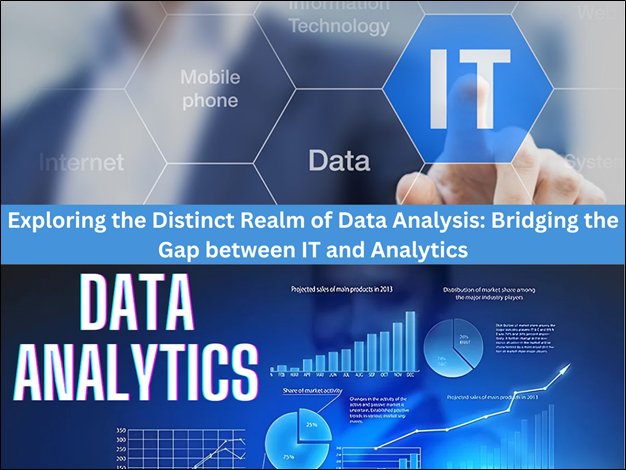Exploring the Distinct Realm of Data Analysis: Bridging the Gap between IT and Analytics

Introduction:
In the modern era of digital transformation, where data has become the new oil fueling innovation and growth, the roles and responsibilities within the technology sector have undergone a significant evolution. One such role that has gained prominence is that of a data analyst. As technology continues to weave its intricate web into every aspect of our lives, the question arises: Is a data analyst an IT job? To unravel this query, we must delve into the realms of both data analysis and information technology, understanding their interplay, differences, and commonalities.
Defining Data Analysis and IT:
Data analysis is the process of examining, cleaning, transforming, and modeling data to identify valuable insights, make inferences, and support decision-making. It industry involves a keen eye for patterns, statistical acumen, and domain expertise. On the other hand, Information Technology (IT) encompasses the utilization of computers, software, networks, and electronic systems to store, process, transmit, and manage information. IT professionals ensure the smooth functioning of these technologies, addressing technical issues and optimizing infrastructure.
The Overlapping Dimensions:
While data analysis and IT possess distinct characteristics, they do share common ground, leading to the occasional blurring of boundaries between the two. In the context of data analysis, IT serves as the backbone that supports the entire data lifecycle. From collecting and storing data to providing the necessary computational power for analysis, IT infrastructure plays a pivotal role. Without robust IT systems, data analysts would find their efforts hindered, as data processing and storage would become arduous tasks.
Furthermore, the convergence of data analysis and IT has given rise to the field of "data engineering." Data engineers build and maintain the architecture that enables data analysts to access, process, and analyze vast datasets. This symbiotic relationship underscores the interconnectedness of these roles.
Distinct Skill Sets:

While data analysis and IT exhibit synergies, they require distinct skill sets. A data analyst must possess a deep understanding of statistical methods, data visualization, and domain knowledge. Their primary objective is to extract insights from data, often in collaboration with domain experts, to inform strategic decisions. Data analysts decipher trends, identify correlations, and create predictive models that drive business growth.
In contrast, IT professionals possess expertise in system administration, network management, cyber security, and software development. Their focus is on ensuring the security, reliability, and scalability of technical infrastructure. IT specialists troubleshoot issues, implement software solutions, and safeguard digital assets from threats.
Scope and Responsibilities:
The scope of a data analyst's role typically revolves around data-driven decision-making. They work closely with various departments to identify trends, optimize processes, and devise strategies. Their work finds applications in marketing, finance, healthcare, and virtually every sector where data-driven insights are valued.
On the other hand, IT professionals operate behind the scenes to ensure seamless technological operations. They manage hardware, software, networks, and databases to maintain an organization's technological ecosystem. IT experts safeguard data integrity, prevent data breaches, and enable efficient communication between different components of the infrastructure.
Collaboration for Success:

In today's interconnected world, the lines between roles are often fluid, and collaboration is paramount. The synergy between data analysts and IT professionals is a testament to this reality. Effective data analysis requires access to clean, well-maintained data, which is made possible by robust IT infrastructure. Conversely, IT professionals rely on data analysis to optimize system performance and anticipate potential issues.
When a data analyst works on developing a predictive model, IT professionals ensure that the required computational resources are available. Data security measures implemented by IT directly impact the data analyst's ability to work with sensitive information. In this context, the roles intertwine to create a holistic technology ecosystem.
Conclusion:
So, is a data analyst an IT job? The answer lies in the intricate dance between data analysis and information technology. While distinct in their skill sets, responsibilities, and objectives, these roles are undeniably interconnected. Data analysts harness the power of data to extract insights, shape strategies, and drive growth. Meanwhile, IT professionals build and maintain the technological foundation that enables these analyses to take place seamlessly.
In the digital age, where information is king, the roles of data analysts and IT professionals continue to evolve in parallel, responding to the demands of an increasingly data-driven world. The question itself, though seeking a clear-cut answer, underscores the complexity and interconnectedness that define the modern technological landscape. In the end, whether we label a data analyst's role as strictly "IT" or not, the undeniable truth is that both data analysis and IT are essential cogs in the machinery that powers our digital society.










